Solar Panel Operations and Maintenance
Solar panel operations and maintenance are vital for keeping your system running smoothly. Regular upkeep helps your solar panels work better and last longer. By taking care of your panels, you can save money on energy bills and reduce your carbon footprint.
Proper care of your solar panels includes cleaning, checking for damage, and making sure all parts are working well. You might need to trim nearby trees or remove debris that could block sunlight. It’s also important to keep an eye on how much power your system is making.
Some tasks you can do yourself, but others may need a professional. Hiring an expert for yearly check-ups can catch problems early and keep your system in top shape. They can also help with more complex issues like wiring or inverter problems.
Key Takeaways
- Regular cleaning and checks keep solar panels working well
- Yearly professional inspections can spot and fix issues early
- Proper care helps solar panels last longer and save more money
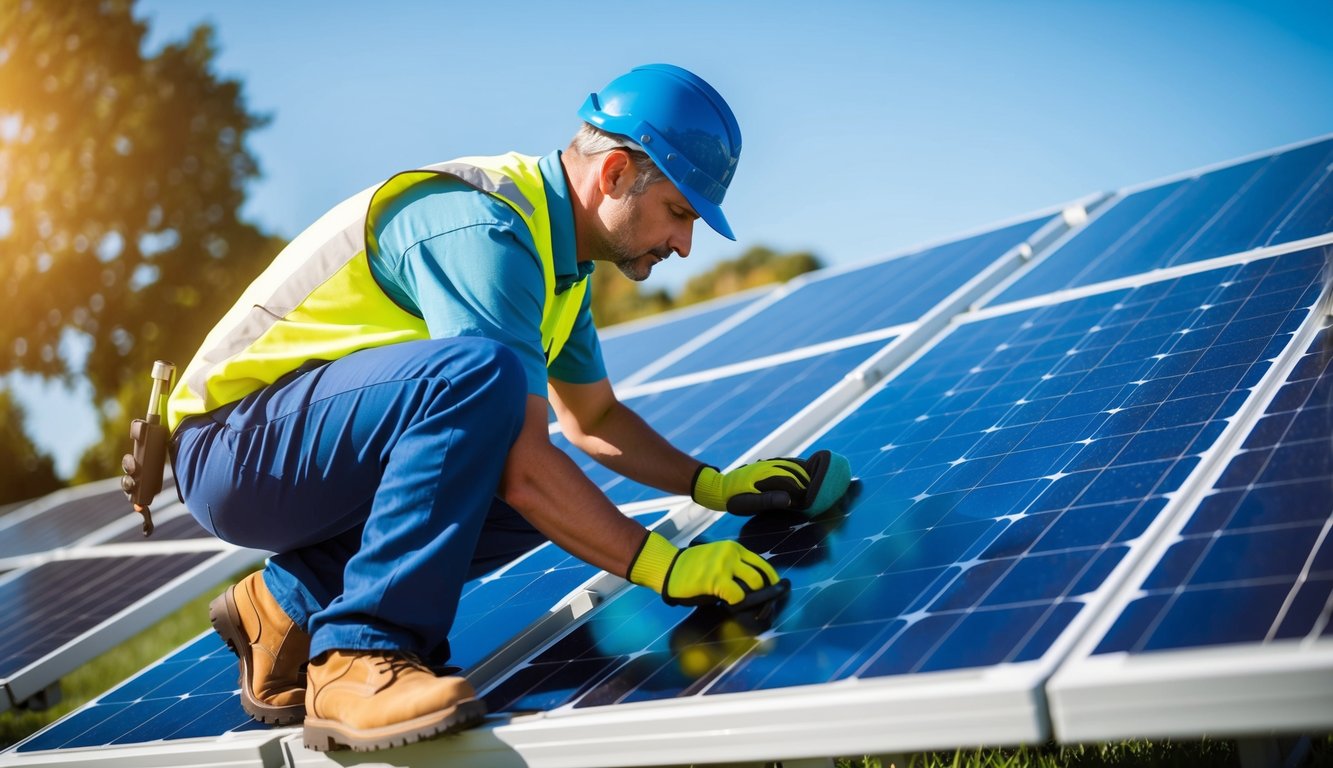
Understanding Solar Panel Systems
Solar panel systems are complex yet efficient setups that convert sunlight into usable electricity. These systems consist of several key components working together to generate clean energy for homes and businesses.
Basic Components Overview
A typical solar panel system includes:
- Solar panels: Capture sunlight and convert it to electricity
- Inverter: Changes DC power to AC for use in buildings
- Mounting structure: Secures panels to roofs or ground
- Wiring: Connects system components
- Meter: Tracks energy production
Some systems also use batteries to store extra power for later use. The size and number of components vary based on energy needs and available space.
How Solar Panels Generate Power
Solar panels create electricity through the photovoltaic effect:
- Sunlight hits the panel’s silicon cells
- Electrons in the silicon are knocked loose
- These electrons flow through the panel, creating an electric current
- The inverter changes this DC current to AC power for home use
This process happens silently and without moving parts, making solar panels a reliable source of clean energy.
Types of Solar Panel Installations
Solar panels can be set up in various ways:
- Rooftop: Most common for homes and small businesses
- Ground-mounted: Used when roof space is limited
- Solar farms: Large-scale installations for commercial power generation
Each type has its own benefits. Rooftop systems save space, while ground-mounted arrays can be positioned for maximum sun exposure. Solar farms produce vast amounts of power for entire communities.
| Installation Type | Best For | Key Benefit |
|---|---|---|
| Rooftop | Homes, small businesses | Space-saving |
| Ground-mounted | Properties with open land | Optimal positioning |
| Solar farms | Utility-scale power | High energy yield |
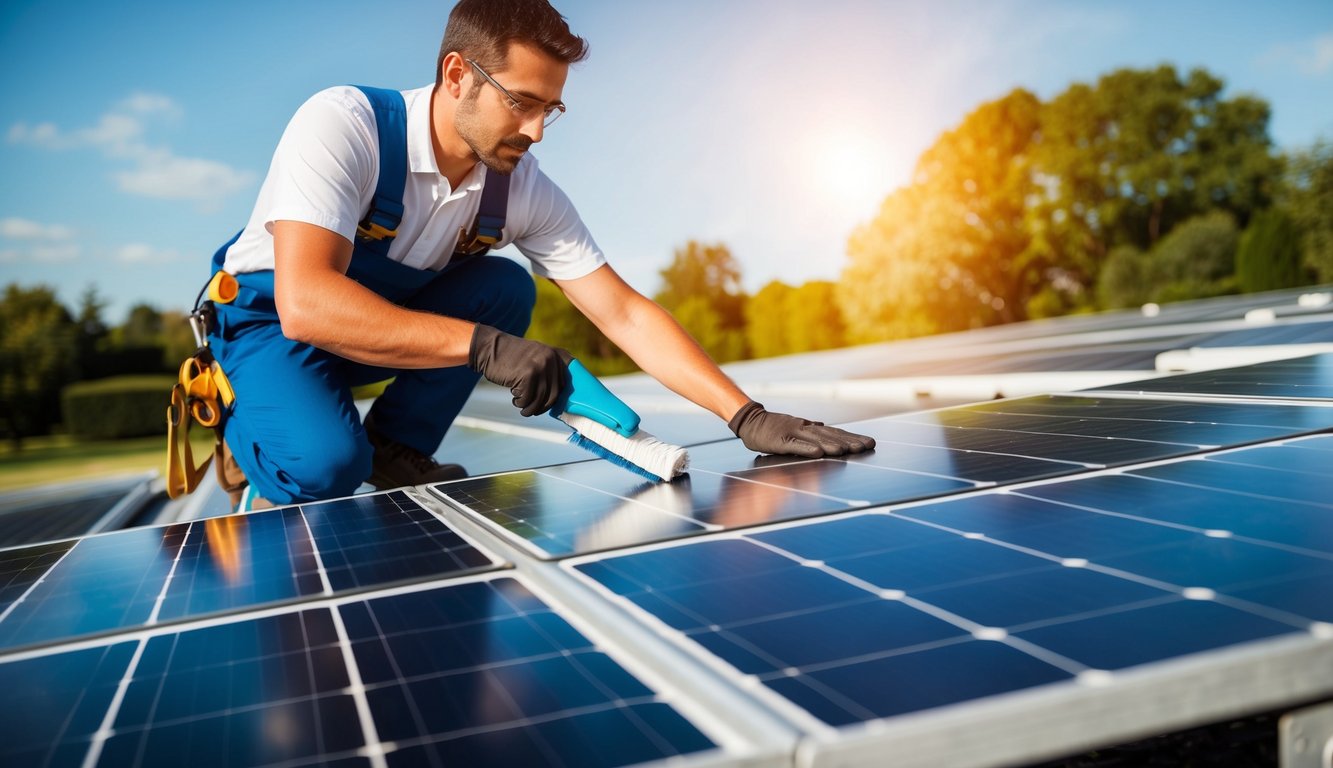
Regular Solar Panel Maintenance Requirements
Solar panels need ongoing care to work well. Proper upkeep helps them last longer and produce more power. Here’s what you should do to keep your panels in top shape.
Cleaning and Inspection Schedules
You should clean your solar panels 2-4 times a year. Rain can wash away some dirt, but not all. Use a soft brush and soapy water to remove stubborn grime. Don’t use harsh chemicals or abrasive tools.
Check your panels every few months for damage. Look for cracks, loose parts, or signs of wear. Trim nearby trees to prevent shade and falling branches.
Set reminders for these tasks. Regular checks help spot issues early. This can save you money on big repairs later.
Performance Monitoring
Keep an eye on your system’s output. Many panels have apps or websites that show daily power production. Check these often to spot drops in performance.
Compare your energy bills before and after getting solar. This helps you see if you’re saving as much as you should be.
If you notice a big drop in power, call a pro. They can test your system and find any problems.
Common Maintenance Tasks
Here are some tasks you might need to do:
- Tighten connections: Loose wires can reduce power output.
- Replace inverters: These usually need changing after 7-10 years.
- Update software: New updates can improve system efficiency.
- Check batteries: If you have storage, test it yearly.
Some jobs need a pro. Don’t try to fix electrical issues yourself. It’s not safe and could void your warranty.
Keep a log of all maintenance. This helps track your panel’s health over time. It’s also useful if you need to make an insurance claim.
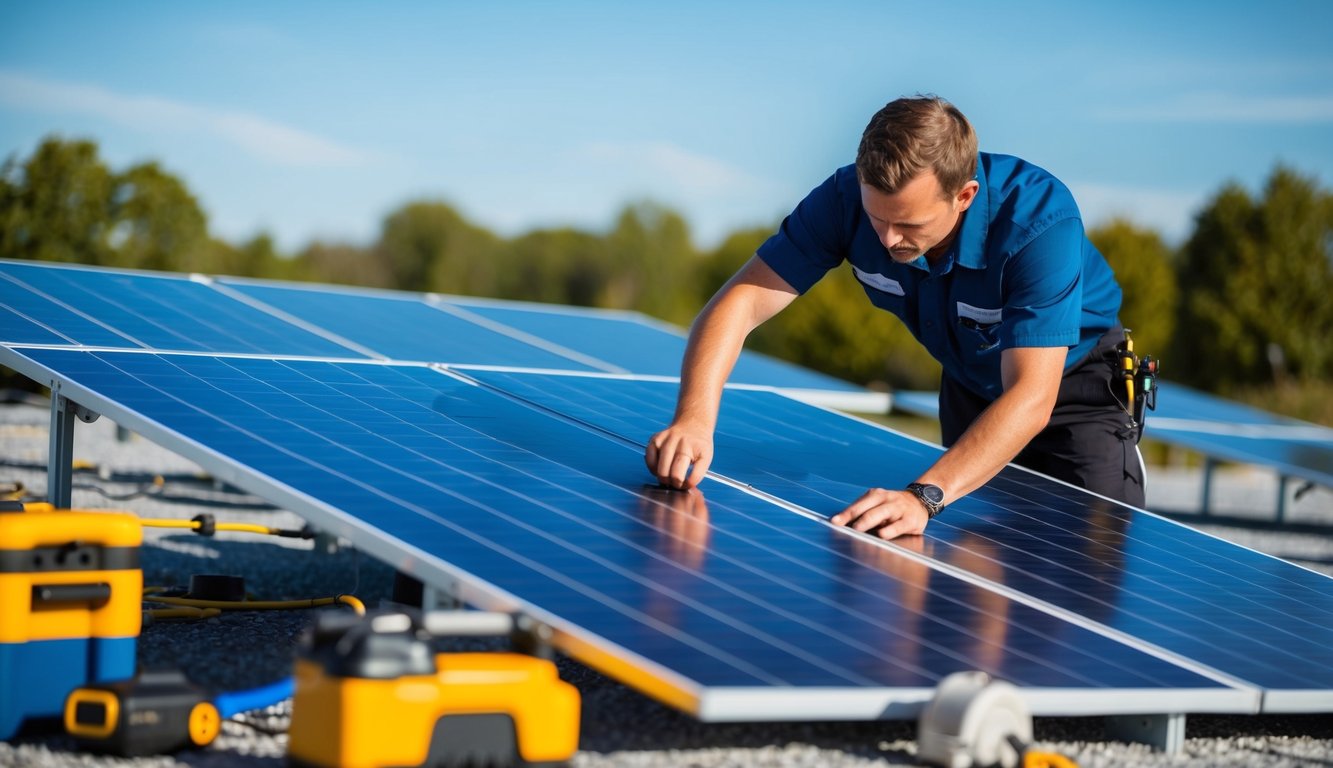
Optimising Solar Panel Performance
Proper setup and ongoing care are key to maximising your solar panels’ output. Regular adjustments and maintenance can boost efficiency and extend the lifespan of your system.
Positioning and Angle Adjustments
Solar panels work best when they face the sun directly. In the UK, panels should typically point south at a 30-40 degree tilt. However, your ideal angle may vary based on your roof and location.
Consider adjustable mounts to change the tilt seasonally. This allows you to capture more sunlight in winter when the sun is lower. In summer, a flatter angle often works well.
Check panel orientation regularly. Even small shifts can reduce output. Use a compass or smartphone app to verify alignment. If needed, ask a professional to realign the panels.
Shade Management
Shade is a major efficiency killer for solar panels. Even partial shade on one panel can drag down the whole system’s performance.
Trim trees and bushes that cast shadows on your panels. Do this at least yearly, ideally in late winter before new growth starts.
Consider microinverters or power optimisers. These allow each panel to operate independently, reducing the impact of partial shading.
Monitor for new sources of shade, like neighbouring construction. If persistent shading is unavoidable, you may need to relocate affected panels.
Weather Impact Considerations
UK weather can affect solar panel output in several ways. Rain helps keep panels clean, but heavy cloud cover reduces production.
In winter, clear any snow off panels promptly. Even a thin layer blocks sunlight. Use a soft brush on a long pole to avoid damaging the panels.
Strong winds can loosen mountings. Check fastenings after storms. Also look for any debris that may have blown onto the panels.
Hot weather can actually reduce panel efficiency. Ensure proper ventilation behind the panels to help them stay cool.

Troubleshooting Common Solar Panel Issues
Solar panels can face various problems that affect their performance. Identifying and fixing these issues promptly helps maintain optimal energy production.
Reduced Power Output
Solar panels might generate less electricity than expected due to several factors. Dirt and debris on the panels can block sunlight. Clean your panels regularly with water and a soft brush. Shading from trees or nearby structures also reduces output. Trim overhanging branches or consider moving panels to a sunnier spot.
Degradation over time is normal, but rapid power loss may signal deeper issues. Check for hot spots or discoloration on panels, which can indicate cell damage. If you notice these signs, call a professional for inspection.
Weather conditions affect panel efficiency too. Cloudy days and extreme heat can lower output. While you can’t control the weather, knowing its impact helps set realistic expectations for daily energy production.
Physical Damage Assessment
Inspect your panels often for visible harm. Look for:
- Cracks in the glass or cells
- Loose or damaged frames
- Water seepage under the glass
Even small cracks can let moisture in, leading to electrical issues. Loose frames may cause panels to shift, reducing efficiency. If you spot any damage, don’t try to fix it yourself. Contact a certified solar technician for repairs.
Hail, falling branches, or extreme weather can cause physical damage. After storms, check your system carefully. Take photos of any damage for insurance claims.
Electrical Problems
Faulty wiring or connections can severely impact your system’s performance. Signs of electrical issues include:
- Fluctuating power output
- System shutdowns
- Error messages on your inverter
Check all visible cables for signs of wear, rodent damage, or loose connections. Do not touch or attempt to fix electrical components yourself. It’s dangerous and may void your warranty.
A licensed electrician or solar specialist should handle all electrical repairs. They can use special tools to test for faults in the system safely.
Inverter Issues
The inverter is crucial for converting DC power from panels to usable AC electricity. Common inverter problems include:
- Overheating
- Error codes on display
- Complete failure to turn on
Check the inverter’s location first. Ensure it’s in a cool, dry place with good airflow. Clean any dust or debris from vents regularly.
If you see error codes, note them down and refer to your user manual. Some codes indicate minor issues you can fix, while others need professional attention.
Inverters typically last 10-15 years, shorter than solar panels. If your inverter is old and frequently malfunctioning, it might be time for a replacement.
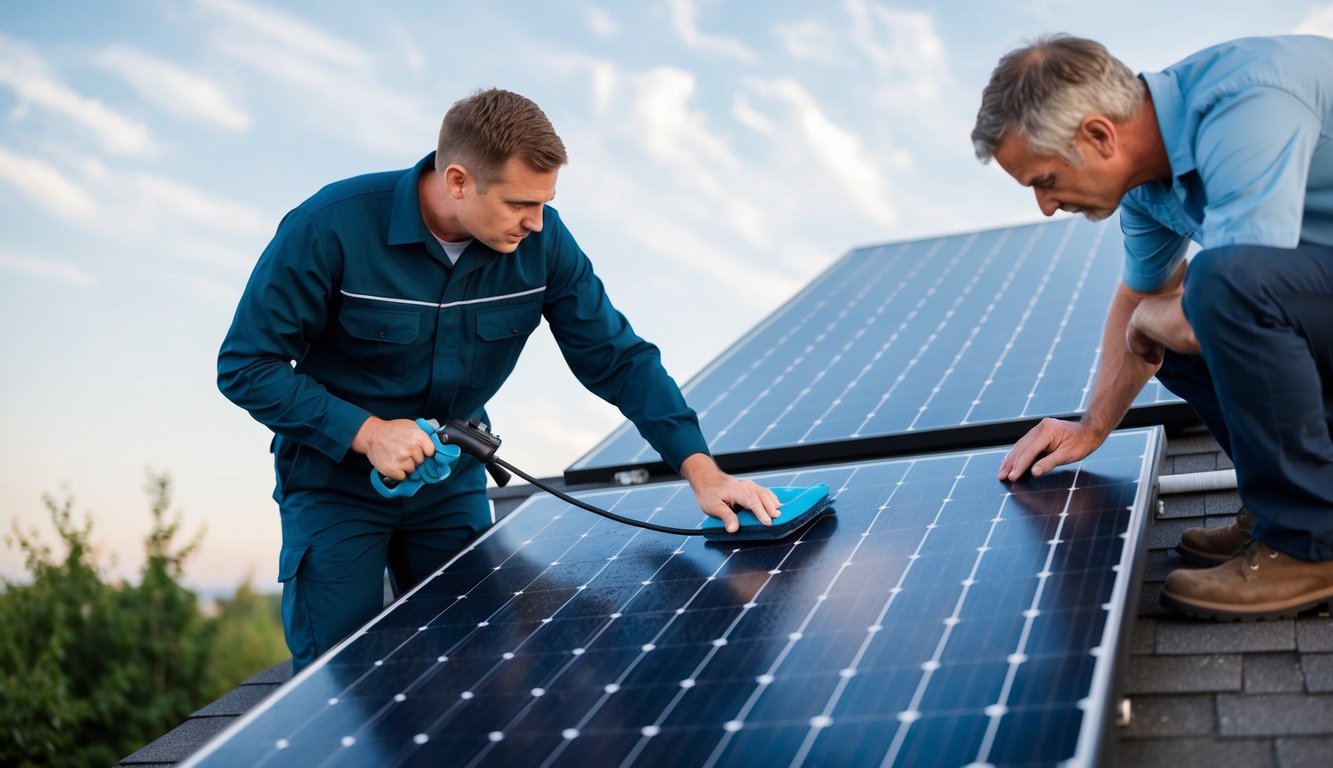
Professional Versus DIY Maintenance
Solar panel upkeep involves a mix of professional and do-it-yourself approaches. Choosing between the two depends on your skills, time, and budget. Safety and effectiveness are key factors to consider.
When to Call Professionals
Professional solar panel maintenance is crucial for complex issues. You should ring experts for:
• Electrical problems: Faulty wiring or inverter troubles
• Physical damage: Cracked panels or loose mountings
• Performance drops: Unexplained dips in energy output
Professionals have the right tools and know-how to handle these tricky tasks. They can spot hidden issues that might escape your notice. Their work often comes with guarantees, giving you peace of mind.
Yearly check-ups by pros can keep your system in top shape. They can clean hard-to-reach panels on tall buildings. For large solar farms, professional teams are a must.
Safe DIY Maintenance Practices
You can handle some solar panel care on your own. Here are safe DIY tasks:
• Visual checks: Look for dirt, leaves, or snow on panels
• Gentle cleaning: Use soft brushes and water to remove light grime
• Shade management: Trim nearby trees to avoid shadows on panels
Always clean panels from the ground or a safe platform. Never climb on your roof without proper safety gear. Avoid harsh chemicals or abrasive tools that might scratch the panels.
Keep a log of your DIY efforts. This helps you track panel performance over time. If you notice any odd changes, it’s time to call the pros.
Cost Considerations
DIY maintenance can save you money in the short term. But weigh this against potential risks and long-term costs.
Professional services typically cost £100 to £200 per year for home systems. This might seem steep, but it can prevent costly damage. Pros can also boost your system’s efficiency, leading to higher energy savings.
DIY costs are mainly your time and basic cleaning tools. Yet, if you make a mistake, repair costs could be high. Think about your comfort level with heights and electrical systems.
| Maintenance Type | Pros | Cons |
|---|---|---|
| Professional | Expert knowledge, Proper tools, Warranty protection | Higher upfront cost |
| DIY | Cost-effective, Flexible timing, Personal control | Risk of mistakes, Time-consuming |
Your choice depends on your system’s size, your skills, and your budget. A mix of both approaches often works best for most solar panel owners.
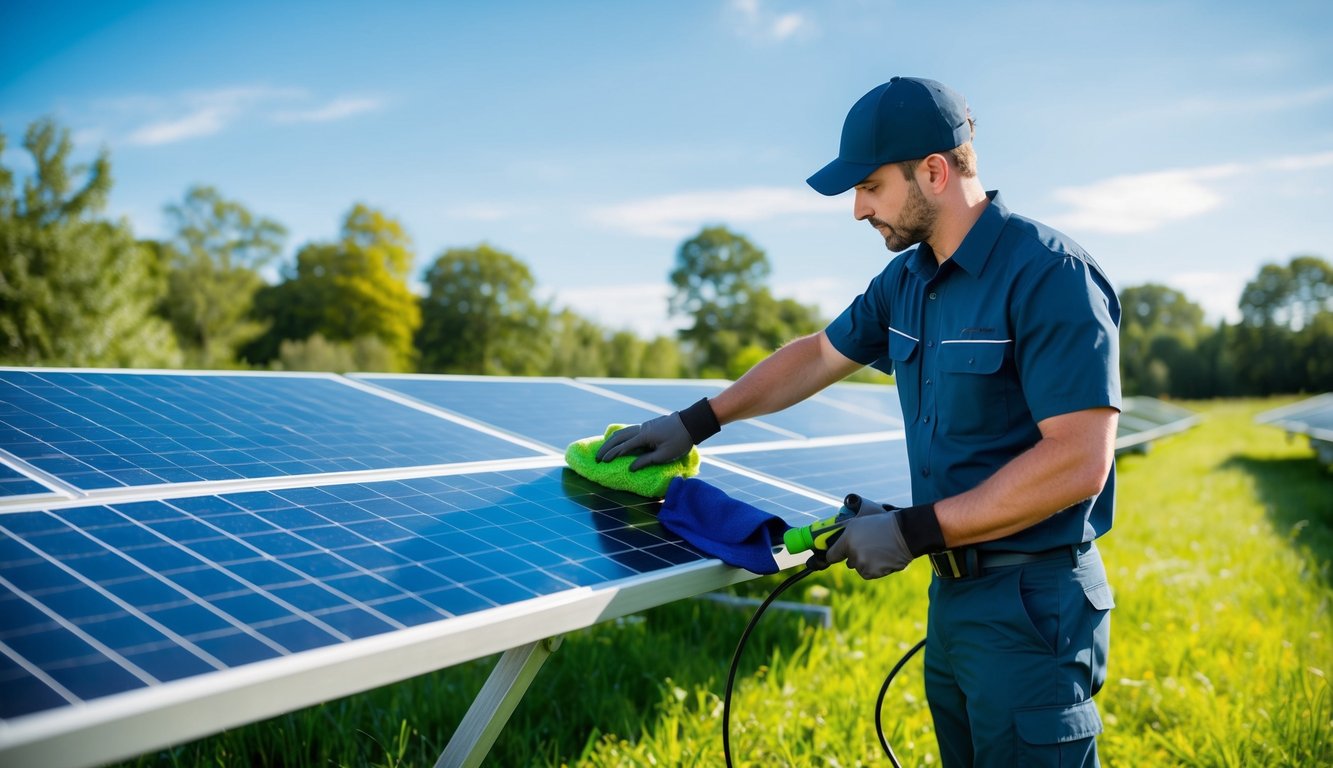
Extending Solar Panel Lifespan
Proper care and maintenance significantly boost solar panel longevity. Regular upkeep, equipment upgrades, and system modifications can help your solar panels last well beyond their typical 25-30 year lifespan.
Preventive Maintenance Tips
Clean your panels regularly to remove dirt and debris. Use soft cloths and mild detergents to avoid scratching. Aim for quarterly cleanings, or more often in dusty areas.
Check for damage after storms. Look for cracks, loose connections, or fallen branches. Address issues promptly to prevent further harm.
Trim nearby trees to reduce shade and falling leaves. Maximise sunlight exposure for better efficiency.
Monitor panel output. Use your inverter or a monitoring system to spot performance drops early. This helps catch issues before they worsen.
Keep panels cool. Ensure proper airflow around the array. Consider adding fans or upgrading to more heat-resistant models if overheating is a concern.
Equipment Upgrades
Replace outdated inverters. Newer models are more efficient and have better monitoring features. Consider upgrading every 10-15 years.
Upgrade to smart junction boxes. These help manage panel output and can bypass underperforming cells.
Install micro-inverters or power optimisers. These devices maximise each panel’s output, reducing the impact of shading or damage.
Add a backup battery system. This reduces grid dependence and can extend panel life by smoothing energy flow.
| Upgrade | Benefit |
|---|---|
| New inverter | Improved efficiency |
| Smart junction boxes | Better performance management |
| Micro-inverters | Optimised output per panel |
| Backup battery | Smoother energy flow |
System Modifications
Adjust panel tilt seasonally. This maximises sunlight exposure throughout the year. Use adjustable racking systems for easy changes.
Add a solar tracker. These systems follow the sun’s path, increasing energy production by up to 25%.
Install a solar concentrator. These devices focus more sunlight onto your panels, boosting output.
Implement a panel rotation system. This spreads wear evenly across all panels, extending overall system life.
Consider adding a cooling system. Water or air cooling can reduce panel temperature, improving efficiency and lifespan in hot climates.
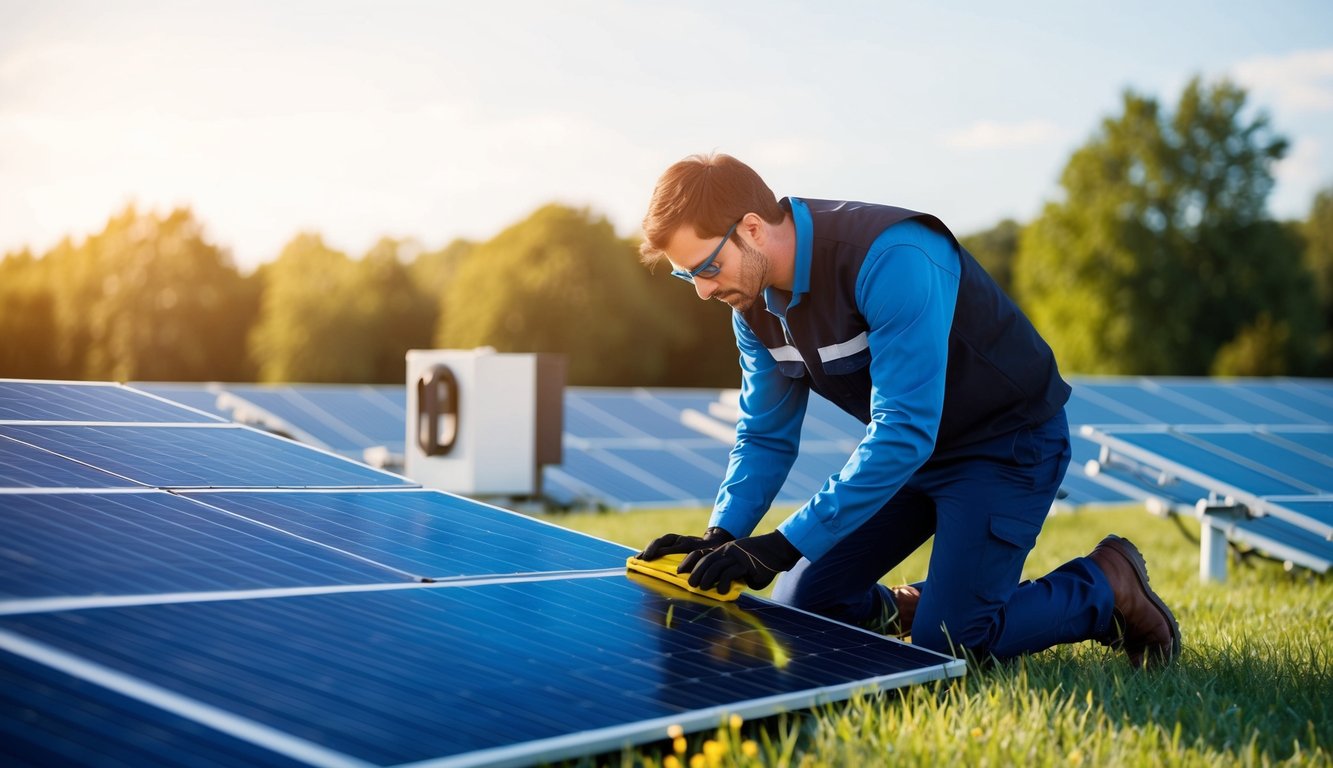
Monitoring and Documentation
Proper monitoring and documentation are crucial for maintaining solar panel efficiency. Regular tracking helps identify issues early and ensures optimal performance over time.
Performance Tracking Methods
Solar panel owners can use various methods to monitor system output. Digital monitoring tools offer real-time data on energy production. These often include mobile apps that display daily, monthly, and yearly generation figures.
Some key metrics to track:
- Daily energy output
- Peak power generation
- System efficiency
Remote monitoring systems allow you to check performance from anywhere. They can send alerts if output drops unexpectedly.
Many inverters have built-in monitoring capabilities. These devices convert DC power from panels to AC power for home use. They often display performance data on a small screen.
Maintenance Records
Keeping detailed maintenance logs is vital for solar panel upkeep. Record all cleaning sessions, inspections, and repairs. This helps track the system’s health over time.
A typical maintenance log might include:
- Date of service
- Type of maintenance performed
- Any issues found
- Parts replaced
- Name of technician
Store these records in a safe place. Digital copies can be helpful for easy access and sharing with professionals.
Regular log reviews can reveal patterns. You might notice certain panels need more frequent cleaning or maintenance.
Warranty Compliance
Proper documentation is essential for warranty claims. Most solar panels come with long-term warranties, often 25 years or more.
Key points for warranty compliance:
- Keep all original paperwork
- Follow manufacturer’s maintenance guidelines
- Use approved cleaning methods
Document any damage or defects immediately. Take photos and note the date of discovery. Contact your installer or the manufacturer promptly if you spot issues.
Some warranties require professional inspections. Schedule these as needed and keep records of all visits.
Conclusion
Solar panel operations and maintenance are crucial for optimal performance. Regular upkeep ensures your system runs efficiently and lasts longer. You can maximise energy output by keeping panels clean and free from debris. Routine inspections help catch issues early, preventing costly repairs.
Here are key points to remember:
• Cleaning: Wash panels regularly to remove dirt and grime
• Inspections: Check for damage or loose connections quarterly
• Monitoring: Keep track of energy production to spot problems
• Professional help: Hire experts for complex repairs and annual check-ups
By following these steps, you’ll get the most from your solar investment. Proper care leads to better energy production and lower electricity bills. It also extends the life of your system, saving you money in the long run.
Remember, a well-maintained solar system is a reliable one. With consistent care, you can enjoy clean, renewable energy for years to come.

